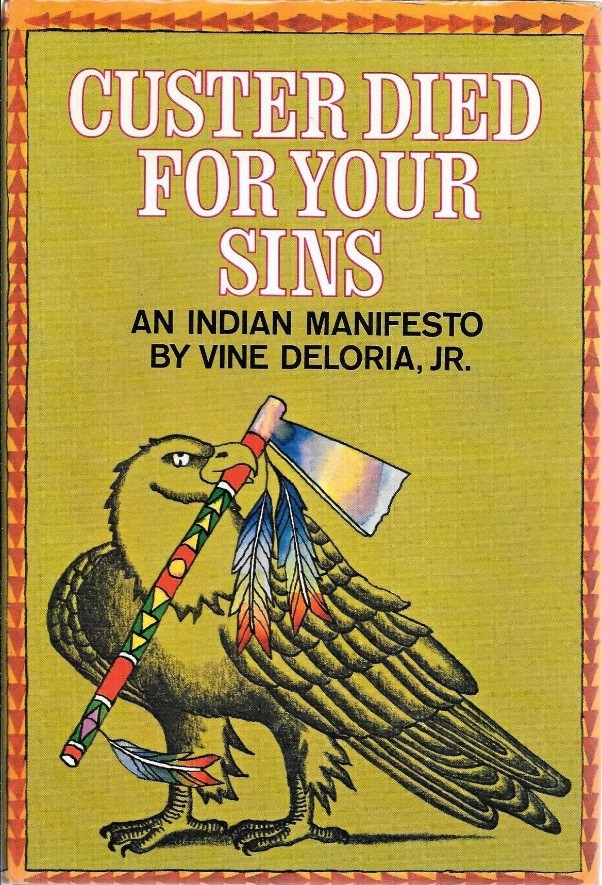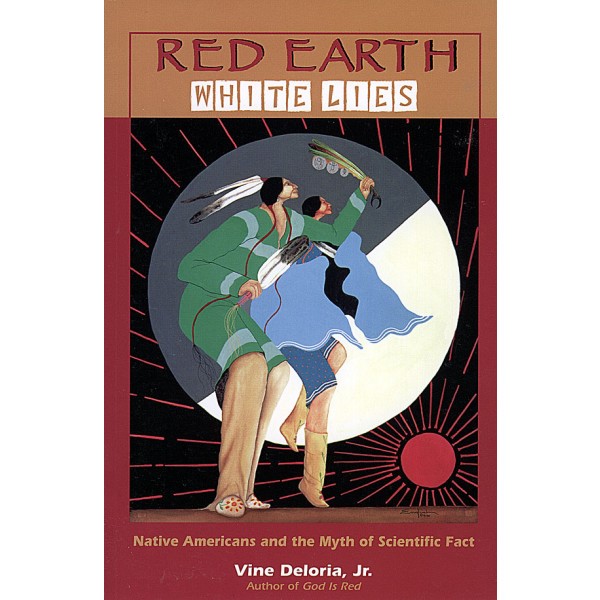Vine Deloria, Jr.
by Stefan Krause, 08/28/2018.
Summary
At a time when American Indian tribes were facing termination, assimilation, and legal discrimination, Vine Deloria, Jr. was one of the most important voices to defend their traditional rights and beliefs in the public sphere. A member of the Standing Rock Sioux Tribe, a historian, and activist, Deloria authored more than two dozen books that argued for an improvement of the situation of Indigenous tribes and challenged the universal authority of Western science and religion. His book Custer Died for Your Sins (1969) became a manifesto for the Red Power movement of the 1970s. His fundamental critique of ethnocentric bias in Western sciences in Red Earth, White Lies (1997) became a main inspiration for this research project.
Vine Victor Deloria, Jr. was born in Martin, South Dakota, on March 26, 1933. He was the son of Vine V. Deloria, Sr. – an Episcopal priest and an enrolled member of the Standing Rock Sioux Tribe – and Barbara S. Eastburn Deloria. His grandfather, Philip J. Deloria, was the son of the Yankton Chief Francois (Saswe) des Laurier and one of first members of the Sioux Nation to be ordained an Episcopal priest (DeMallie, 932). Deloria is also the nephew of Ella Cara Deloria, a Yankton Dakota educator and anthropologist, who collaborated with famous anthropologists like Franz Boas and Ruth Benedict. As a member of the Standing Rock Sioux Tribe, he grew up in the area of the Pine Ridge Oglala Sioux Indian Reservation, where he attended reservation school. Following his service in the Marine Corps from 1954-56, Deloria attended Iowa State College, where he met his future wife of 50 years, Barbara Jeanne Nystrom, with whom he had three children (DeMallie, 932).
After graduating from Iowa State College in 1958 with a bachelor’s degree in General Science, Deloria enrolled at the Lutheran School of Theology in Rock Island, Illinois, where he received a master’s degree in theology in 1963 (Watkins, 506). He was elected executive director of the National Congress of American Indians (NCAI) 1964-1967 – an experience that showed him the great importance of political activism in the attempt to regain tribal sovereignty (DeMallie, 932). A trained theologian, Deloria decided not to become a clergyman like his father but enrolled at the University of Colorado’s School of Law in an effort to support the legal claims of American Indians. He earned his J.D. in 1970 and established the Washington D.C. based Institute for the Development of Indian Law in 1971, which he chaired until 1976. This was the time when Native American tribes and organizations were busy lobbying for international recognition, e.g. through the International Indian Treaty Council, founded in 1974, which obtained NGO status with the Economic and Social Council of the United Nations in 1977.
Deloria was a Native rights activist; his book Custer Died for Your Sins: An Indian Manifesto (1969) fueled the Red Power movement and provided the necessary intellectual substrate to demonstrations for tribal sovereignty in the seventies. Its popularity with Native Americans themselves greatly increased when the famous Indian folk singer Floyd Westerman put some of the book chapters to popular resistance tunes. Just a year prior to the book’s publication, the Indian Civil Rights Act had been passed and the American Indian Movement (AIM) had been formed. The following years were marked by political conflicts such as the occupation of Alcatraz Island (1969), the Trail of Broken Treaties (1972), and the standoff between American Indians and the FBI at Wounded Knee in 1973. During this time, Deloria was busy representing the interests of American Indians in legal cases.
Vine Deloria, Jr. began his career as teacher in 1970, when he started working as a lecturer in Ethnic Studies at Western Washington State College. During his time he also collaborated with the Lummi Tribe to study their legal history and help them set up alternative economic strategies, such as a sustainable aquaculture project, as described in his book Indians of the Pacific Northwest (1977). In the years after 1972, Deloria decided to focus on writing and moved to Golden, Colorado. In 1978 he accepted a professorship for law and political science at the University of Arizona. In 1990 he began teaching history, political science, law, and religious studies at the University of Colorado, Boulder, until his retirement in 2000 (DeMallie, 933). He returned to Arizona, where he continued to write and lecture until his passing on November 15, 2005.
“Whip smart and Coyote clever”
In his long career, Deloria published more than two dozen books and numerous essays. His writing was famous for its critical and at times polemical tone that would provoke readers to think over their convictions. American Indians found strength and inspiration in Deloria and his words. Cheyenne and Hodulgee Muscogee poet Suzan Shown Harjo described Deloria as “Whip smart and Coyote clever; Tossing banana peels beneath the feet of the pompous” (Deloria, Jr. 2007, xii). In his books he argues for tribal sovereignty and he confronts often misrepresented Indian knowledge with what he called scientific ‘beliefs’.
Among his numerous books, Custer Died for Your Sins is undoubtedly the most popular one. Here Deloria attacks non-Indian stereotypes and misrepresentations of American Indians and criticizes the role of the American government, missionaries, treaties, and anthropologists. It was one of the first critical books that presented an Indigenous perspective on the relationship between American Indians and American society. The book’s witty and sharp line of argument lashes out against the pretension held by many whites of the time that “[t]hey understand Indians” (Deloria, Jr. 1988, 5). In his humorous and sometimes sarcastic style, Deloria debunks the myth of the sorry Indian looking for an American identity; he criticizes how Euroamericans have forced American Indians into poverty and how the loss of their land has threatened their traditional way of life. The book also inspired some critical self-reflection and change in the scientific community. For example, the chapter “Anthropologists and Other Friends” played a crucial role in anthropology’s rethinking of its treatment of indigenous people, artifacts, and sites. In the chapter, Deloria (1988, 81) attacks the anthropological practice of treating people as “objects for experimentation, for manipulation, and for eventual extinction”, while arguing that money used for anthropological studies on poor American Indian tribes should be used to actually fight poverty on reservations. Although many anthropologists were skeptical of Deloria’s argument about scientific methods, at least one of them, Joe Watkins, admits that “he forced us into the fray” (507).
Many of Deloria’s other publications present Indian beliefs and political demands to a broad readership. In God Is Red (1972/1992), for example, Deloria gives an outline of American Indian spirituality as opposed to monotheistic religious beliefs such as Christianity, Islam, and Judaism. He explains that there are “natural people” (e.g. American Indians), who seek to live in harmony with nature, and “hybrid people” (e.g. Christians), who believe that nature was given to them to be exploited (Deloria 1992, 2). First published before the American Indian Religious Freedom Act was enacted in 1978, the book also provoked readers to reflect on Christianity and how Christians have treated American Indians. The 1992 edition of God is Red contains an additional chapter on “Sacred Places and Moral Responsibility” where Deloria distinguishes between four categories of scared places (sites of historical-mythical importance; sites of transcendental revelations in the deeper mythical past, sites that have an “inherent sacredness” and have been sought for spiritual inspiration by successive cultures; and, fourth, potential future sites of spiritual revelation which are yet unknown (1992, chapter 16). He declares sacred places to be the “foundation of all other beliefs and practices” of a culture “because they represent the presence of the sacred in our lives. They properly inform us that we are not larger than nature and that we have responsibilities to the rest of the natural world that transcend our own personal desires” (281). Behind the Trail of Broken Treaties (1974) examines the status of Indian tribes, as recorded in treaties or the US Constitution, and suggests what political rights American Indian tribes should be given nationally and internationally. Deloria’s professional involvement with and dedication to American Indian law also shows in American Indians, American Justice (1983), co-authored with Clifford M. Lytle. The volume depicts the complex legal situation of American Indians and gives an overview of the legal cases and terminology relevant to the topic. In Tribes, Treaties, and Constitutional Tribulations (1999) Deloria and David E. Wilkins address similar topics and explore to what extent the United States Constitution offers rights to the tribes.
In his later publications, Deloria increasingly discussed the role of Western science and of scientific racism and their relationship to Indigenous knowledge systems. His most influential book in this regard is Red Earth, White Lies (1997). The book attacks scientific theories such as the settlement of the Americas via the Bering land bridge and the concept of evolution, but also lashes out against scientifically dubious claims such as the Pleistocene Overkill Hypothesis. While Deloria criticizes scientific disciplines like geology and archaeology for their orthodox and ethnocentric approaches, he advocates more holistic narratives of the geological past that combine Indigenous oral traditions and scientific evidence (e.g. Dorothy Vitaliano’s ‘geomythology’). In Evolution, Creationism, and Other Modern Myths (2002) Deloria went a step further and offered a critique of both science and religion by looking at evolutionist and creationist positions. His life-long concern with the contact zone between science and the spiritual world manifested itself in his posthumously published book exploring affinities between Native American spiritual traditions and the psychological theories of C.G. Jung now largely banned from serious scientific thought. An overview of Deloria’s wide field of interest was made available in the reader Spirit and Reason (1999), which was critically acclaimed by receiving the Wordcraft Circle Writer of the Year Award in the same year.
“The Myth of the Objective Scientist”
In Red Earth, White Lies, Deloria makes many provocative statements, to say the least. The whole book as a sharp polemic against Western science and the coloniality of many of its assumptions and theories. In the opening sentence he explains that he “grew up believing the myth of the objective scientist” (Deloria 1997, xiii). He refers to scientific racism and ethnocentric bias. Deeply rooted in the American episteme, these theories not only shaped the beginnings of disciplines like anthropology, but are still lingering in recent ‘scientific’ contributions explaining the inequality between different ethnic groups. Although the past three decades have brought a wave of critical academic self-reflection, the Western colonial episteme continues to influence scientific thought. In spite of its regrettable superficiality and its polemic character which render some of its counter-scientific claims untenable, Red Earth White Lies is an important intervention into residually white supremacist claims that keep showing up in the cloak of science. For example, the colonial narrative of the white settlement of “virgin” America (Perry Miller’s “vacant wilderness”) is reflected in constructs from the scientific margin (e.g. the Solutrean Hypothesis LINK). The narratives often go hand in hand with refusing or belittling other forms of knowledge such as Indigenous oral tradition. Deloria has made out these tendencies and offered ways to combine different knowledge systems. Although one would have wished for a more in-depth analysis of Indigenous counter-narratives to the colonial myths he debunks, Deloria’s book is an important clarion call for opening up new research fields that would give prevalence to Indigenous oral traditions. In this regard, his work has inspired and shaped our research project tremendously.
Similar to Walter Mignolo and his concept of the ‘coloniality of knowledge’, Deloria points out the colonial baggage and ethnocentrism wittingly or unwittingly inherent in many scientific theories. Yet Deloria also attacks scientifically accepted theories such as the Bering Land Bridge theory. At the end of the chapter “Low Bridge – Everybody Cross” he concludes that “[t]he Bering Strait exists and existed only in the minds of scientists” (Deloria 1997, 91). Keeping in mind that Deloria wrote the text some twenty years ago, many of his observations regarding the Bering Strait theory are inaccurate and dated. Genetic studies of the human past have convincingly shown that and when the first humans migrated from Asia to the Americas (e.g. Llamas et al.). But genetic studies like these also leave little room for scientific racism, as indicated by the case of the Ancient One/Kennewick Man, where the genetic results clearly confirmed the opinion of the claimant tribes that the Ancient One is one of their distant ancestors. We can only speculate how Vine Deloria would have reacted to these developments but it can be assumed that he would have rejoiced at the outcome of the Kennewick case. As a scholar who was always willing to review his stand based on recent findings he probably would have appreciated the collaboration of science and Indigenous knowledge that eventually ended the debate over Kennewick Man’s ancestry. Certainly, he would also have urged that there is still a huge gap to bridge between scientific and Native narratives.
Deloria’s dedication to challenging scientific theories and his unwavering advocacy of the rights and beliefs of American Indians has gained him respect across political and ethnic groups. He never shied away from challenging people’s beliefs and getting his readers out of their intellectual comfort zone. Deloria emphasized that his personal stand on scientific topics (e.g. the origin of mankind, the origin of the first Americans) and his criticism of Western science and religion “are not beliefs that I would die for, as would many religious people and scientists, but merely points that stick in my craw that I would like smarter people to resolve. I simply bring them to people’s attention” (Deloria, Jr. 1999, xiv). In this manner, Deloria brought important transcultural debates to the attention of Indians as well as a mainstream readership – making the Indians talk while non-Indians, for a change, listened.
WORKS CITED
Deloria, Jr., Vine. Custer Died for Your Sins. An Indian Manifesto. 1969. Norman: University of Oklahoma Press, 1988.
---. We Talk, You Listen. New Tribes, New Turf. 1970. Lincoln: University of Nebraska Press, 2007.
---. Behind the Trail of Broken Treaties. An Indian Declaration of Independence. 1974. Austin: University of Texas Press, 1985.
---. Indians of the Pacific Northwest. From the Coming of the White Man to the Present Day. 1977. Golden, CO: Fulcrum, 2012.
---. God Is Red. A Native View of Religion. 2nd Ed. Golden, CO: Fulcrum, 1992.
---. Red Earth. White Lies. Native Americans and the Myth of Scientific Fact. Golden, CO: Fulcrum, 1997.
---. Spirit and Reason. The Vine Deloria, Jr. Reader. Golden, CO: Fulcrum, 1999.
---. Evolution, Creationism, and Other Modern Myths. Golden, CO: Fulcrum, 2002.
---. Ed. Philip J. Deloria. C.G. Jung and the Sioux Traditions. Dreams, Visions, Nature, and the Primitive. New Orleans: Spring Journal, 2009.
Deloria, Jr., Vine, and Clifford M. Lytle. American Indians, American Justice. Austin: University of Texas Press, 1983.
Deloria, Jr., Vine, and David E. Wilkins. Tribes, Treaties, and Constitutional Tribulations. Austin: University of Texas Press, 1999.
DeMallie, Raymond J. Vine Deloria Jr. (1933-2005). American Anthropologist 108, 4 (2006): 932–940.
Llamas, Bastian, Fehren-Schmitz, Lars, Valverde, Guido, et al. “Ancient Mitochondrial DNA Provides High-Resolution Time Scale of the Peopling of the Americas.” Science Advances 2, 4 (2016). <http://advances.sciencemag.org/content/2/4/e1501385/tab-article-info> last accessed August 28, 2018.
Mignolo, Walter. Local Histories/Global Designs: Coloniality, Subaltern Knowledges, and Border Thinking. Princeton: Princeton University Press, 2012.
Watkins, Joe. “‘He Forced Us into the Fray’: Vine Deloria, Jr. (1933-2005).” Antiquity 80, 308 (2006): 506–507.
ILLUSTRATIONS
Figure 1/Title Picture: Chris Richards. Vine Deloria, Jr. N/A.
Figure 2: Deloria, Jr., Vine. Custer Died for Your Sins. An Indian Manifesto. New York: Macmillan, 1969.
Figure 3: Red Earth. White Lies. Native Americans and the Myth of Scientific Fact. Golden, CO: Fulcrum, 1997.



